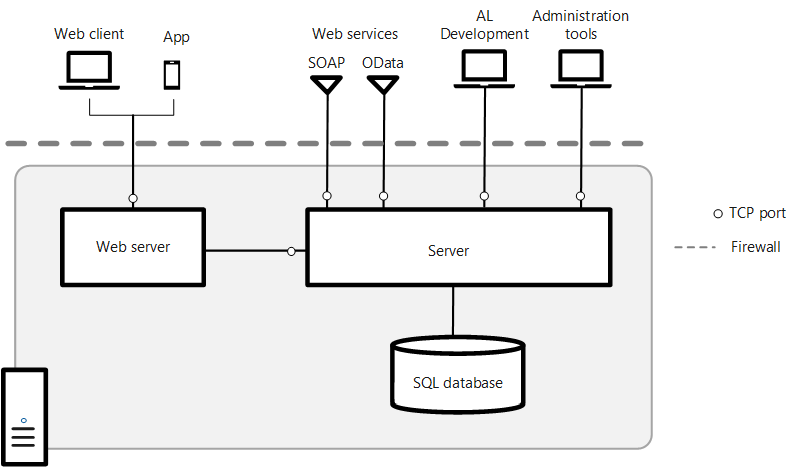Note
Access to this page requires authorization. You can try signing in or changing directories.
Access to this page requires authorization. You can try changing directories.
In this scenario, you install the Business Central Web Server components, Business Central Server, and the SQL Server database components on the same computer.

Pre-Installation Tasks
The following table includes tasks to perform before you install.
| Task | Description | For more information, see |
|---|---|---|
| Make sure that system requirements are met. | Verify that the computer has the required hardware and software installed. | System Requirements |
| Install Internet Information Services. | When you install the Business Central Web Server components, Business Central Setup creates a website for the Business Central Web client on IIS. If IIS is already installed, then make sure that the required features are enabled. Note: This step is optional because instead of installing and configuring IIS manually, you can use Business Central Setup to install IIS and enable the required features by setting the Install IIS Prerequisites option to Yes. |
Configure Internet Information Services |
| Determine the TCP ports for the Business Central Web client, client services, and SOAP/OData web services (optional) and allow communication on the port through Windows Firewall. | Business Central Setup creates a website on IIS. During Setup, you will have to choose the port to use for the site. The default port is port 8080. The client services port facilitates communication between the Business Central Web Server and Business Central Server. The default port is 7085. It's important that you limit access to the port. Learn more at Limiting client services port access. If you will enable SOAP and OData web services, you will also need to specify a port for each. The default ports are 7047 and 7048. If you choose to do so, Business Central Setup will automatically create an inbound rule in Windows Firewall that allows communication on the ports. Otherwise, you will have to do this manually. |
Identity and access management in the Windows documentation. |
| Set up the service account for Business Central Server and the SQL Server database. | Optional. When you install Business Central Server, you can specify a user account that will be used to log on to the Business Central Server instance and Business Central database. The default service account is Network Service. If you want to use Network Service, then no action is required for this task. | Provisioning a Service Account |
| Obtain and install an SSL certificate. | Optional. If you want to configure SSL on the connection to Business Central Web client, then complete the following procedures: - Obtain an SSL certificate. - Import the certificate into the local computer store of the computer on which you will install the Business Central Web Server components. - Obtain the certificate's thumbprint. Note: You can also configure SSL after you have installed the Business Central Web client. For more information, see Post-installation Tasks. |
Configure SSL to Secure the Web Client Connection |
Installation Tasks
The following table includes tasks for installing the Business Central components.
| Task | Description | For more information, see |
|---|---|---|
| Install Business Central Web Server components, Business Central Server, and SQL Server database components. | Run the Business Central Setup setup.exe file, choose the Advanced installation options > Choose an installation option > Custom, and then choose the Server, SQL Server Database Components, Server, and Web Server Components options. | Install Business Central Using Setup |
Post-installation Tasks
The following table includes tasks that configure the Business Central Web Server components after installation. These tasks are optional depending on your organizational and network requirements.
| Task | Description | For more information, see |
|---|---|---|
| Change the user authentication method. | The Business Central supports the following authentication methods: Windows, UserName, NavUserPassword, and AccessControlService. By default, Windows authentication is used. | Authentication and User Credential Type |
| Secure the connection to the Business Central Web client with SSL. | You can help secure Business Central data that is transmitted over the Internet by enabling Secure Sockets Layer (SSL) on the connection to the Business Central Web client. | Configure SSL to Secure the Web Client Connection |
| Change the configuration of the Business Central Web Server. | There are several parameters in the navsettings.json configuration file for the Business Central Web Server that you can modify to change the behavior of the Business Central Web client. Some of the more common parameters include the Business Central Server instance, company, language, time zone, regional settings, session time out, and online Help URL. | Configuring Business Central Web Server |
| Set up multiple Business Central Web client applications. | You can set up multiple web server instances for the Business Central Web client on the existing website. The web server instances will use the same address (URL) except with an alias that specifies the specific application. | Creating and Managing Business Central Web Server Instances Using PowerShell |
| Configure web browsers on devices. | The Business Central Web client supports several different web browsers. To access the Business Central Web client, the web browser must be enabled on a device with cookies and JavaScript. | Web Client Requirements |
Related information
Business Central Web Server Overview
Installing Business Central in a Two Computer Environment
Installing Business Central in a Three Computer Environment